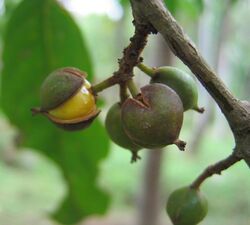Biology:Aporosa
From HandWiki
Short description: Genus of flowering plants
| Aporosa | |
|---|---|

| |
| Aporosa cardiosperma | |
| Scientific classification | |
| Kingdom: | Plantae |
| Clade: | Tracheophytes |
| Clade: | Angiosperms |
| Clade: | Eudicots |
| Clade: | Rosids |
| Order: | Malpighiales |
| Family: | Phyllanthaceae |
| Subfamily: | Antidesmatoideae |
| Tribe: | Scepeae |
| Genus: | Aporosa Blume |
| Synonyms[1] | |
Aporosa is a genus of flowering plant belonging to the family Phyllanthaceae, first described as a genus in 1825.[4] It is native to China , the Indian Subcontinent, Southeast Asia, Papuasia, and Queensland.[1][5][6][7]
These plants are mostly dioecious trees or shrubs.[8] Four species (A. hermaphrodita, A. heterodoxa, A. brevicaudata, and A. egreria) have consistently bisexual flowers, although they may be functionally dioecious.[9] The seeds have brightly colored arils that are attractive to birds, which disperse the seeds.[3]
There are about 80 species.[3]
- Species[1]
- formerly included[1]
moved to other genera: Antidesma Baccaurea Drypetes Shirakiopsis
References
- ↑ 1.0 1.1 1.2 1.3 Kew World Checklist of Selected Plant Families
- ↑ Tropicos, Aporusa Blume
- ↑ 3.0 3.1 3.2 Debski, I., et al. (2002). Habitat preferences of Aporosa in two Malaysian forests: implications for abundance and coexistence. Ecology, 83(7), 2005-2018.
- ↑ Blume, Carl Ludwig von. 1825. Flora Javae 1: vi
- ↑ Govaerts, R., Frodin, D.G. & Radcliffe-Smith, A. (2000). World Checklist and Bibliography of Euphorbiaceae (and Pandaceae) 1-4: 1-1622. The Board of Trustees of the Royal Botanic Gardens, Kew.
- ↑ Schot, A.M. (2004). Systematics of Aporosa (Euphorbiaceae). Blumea. Supplement 17: 1-381.
- ↑ Flora of China Vol. 11 Page 215 银柴属 yin chai shu Aporosa Blume, Bijdr. 514. 1825.
- ↑ Debski, Igor; Burslem, David F. R. P.; Palmiotto, Peter A.; Lafrankie, James V.; Lee, H. S.; Manokaran, N. (2002). "Habitat Preferences of Aporosa in Two Malaysian Forests: Implications for Abundance and Coexistence". Ecology 83 (7): 2005. doi:10.1890/0012-9658(2002)083[2005:HPOAIT2.0.CO;2]. ISSN 0012-9658.
- ↑ Wurdack, Kenneth J.; Hoffmann, Petra; Samuel, Rosabelle; Bruijn, Anette; Bank, Michelle; Chase, Mark W. (2004). "Molecular phylogenetic analysis of Phyllanthaceae (Phyllanthoideae pro parte, Euphorbiaceae sensu lato) using plastid RBCL DNA sequences". American Journal of Botany 91 (11): 1882–1900. doi:10.3732/ajb.91.11.1882. PMID 21652335.
Wikidata ☰ Q4780563 entry
 |
